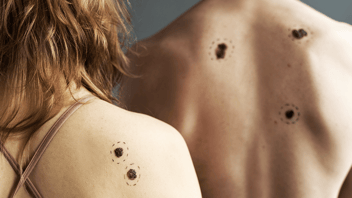
Finding a strange spot on your body can be pretty scary. You don’t know how long it will be there, if it’s dangerous, or what it even is. The best thing you can do when you find weird-looking spot on your body is to visit your dermatologist.
While you’re waiting to see a doctor, you may want to better understand two common types of skin spots: skin cancer and age spots, also known as liver spots. It’s easy to get the two confused, so let’s take a closer look at them.
What Age Spots (Liver Spots) Look Like
Age spots are very common and are usually harmless. When you hit 50 years old, you’ll probably start seeing age spots on your skin, especially if you have pale complexion. They’re caused by years of exposure to UV rays from the sun. If you’re out in the sun a lot, you may start getting age spots earlier than usual. That’s why it’s so important to take care of your skin while in the sun!
You’ll usually find age spots on your hands, shoulders, arms, tops of your feet and upper back. These are the areas of your body that see the sun the most. Though age spots vary in size, you’ll usually see the following characteristics when identifying an age spot, according to Mayo Clinic:
- Flat and oval areas of skin discoloration
- Tan, black or brown in color
- Appear in areas that are commonly exposed to the sun
If you have age spots or any other type of cosmetic brown spot, we can help erase them. Learn more about our brown spot treatments here!
WHAT SKIN CANCER LOOKS LIKE
Unfortunately for all of us, skin cancer can look a lot like age spots. This is why it’s important to visit a dermatologist if you see a new and unusual spot on your skin. Skin cancer comes in many forms, but all are most commonly caused by UV light from the sun or tanning beds (Stay away from those beds, ladies. Instead use safe, DHA-containing tanning lotions and creams). When your skin is constantly exposed to UV rays, abnormal skin cells can begin to grow uncontrollably. We call this growth skin cancer.
Like we said, there are many different types of skin cancer, from purely disfiguring cancers to life-threatening cancers. You can take a look at each of the different types of skin cancers and their characteristics on The Skin Cancer Foundation’s website. Here’s what to look for when identifying skin cancers, according to The Skin Cancer Foundation:
- Any new growths, including moles.
- Any existing growths that change in size, shape, color, elevation or any other way.
- Lesions that change, don’t heal, bleed or itch.
Although melanoma accounts for less than 2% of all skin cancer cases, it is the cause of most skin cancer deaths, according to The Skin Cancer Foundation. That’s pretty scary. If you see a strange spot on your skin, make sure you look for the ABCDE signs of melanoma:
- Asymmetry. Draw an invisible line through the growth. If the two sides aren’t equal, then it is asymmetrical – a warning sign that you might have melanoma.
- Border. The edges of early melanoma are typically uneven and notched.
- Color. Melanoma usually isn’t all one solid color. You may see different shades of brown, black, tan, or even red, white or blue.
- Diameter. Benign growths are typically smaller than melanoma. Although melanoma may be smaller in the very early stages, it’s usually bigger than the eraser on a pencil tip.
- Evolution. Unlike normal moles, melanoma changes over time. If you see any changes in your growth’s characteristics, such as a change in color, elevation, size or symptoms (bleeding, itching, crusting), you should see a doctor.
We hope this article helps you to better understand skin cancer and the spots on your skin. Again, if you notice any new growths or changes in the ones you already have, it’s very important that you see your doctor.
For those of you who have seen a dermatologist and know that your growths are purely cosmetic, we can help you lessen their appearance. Call us to learn more today.
Read On


How to Care for You Babys Dry Skin This Summer
Let’s face it, nothing’s worse than seeing your little baby feeling uncomfortable. Now that summer...

What's The Difference Between Partial Correction & Full Correction?
When considering Botox(r), patients should, not only understand the process and results of Botox,...

